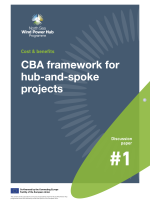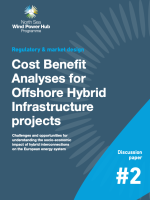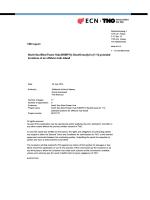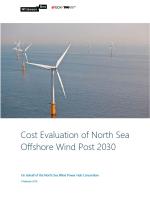CBA framework for hub-and-spoke projects
To facilitate development and implementation of hybrid projects, clarity is required on the Cost and Benefit topic. A Cost and Benefit Analysis (CBA) is a generally accepted approach for reviewing energy infrastructure projects.
This discussion paper aims to show the CBA options that the North Sea Wind Power Hub (NSWPH) consortium partners have, their shortcomings and the decisions the NSWPH still needs to take with regard to the CBA framework for the hub-and-spoke concept. The discussion paper also provides insights into discussions that still need to take place between policy makers.
While this discussion paper is focusing on providing an adequate application of a CBA framework for a hub-and-spoke project, the considerations included in this discussion paper are valid in case projects cover more than just a single functionality (unlike conventional projects).
Executive summary
The deployment of renewable energy sources in Europe will increase significantly to support the goal of net zero greenhouse gas emissions by 2050. Energy scenarios consider offshore wind as a major renewable energy source in the future European energy system. To support the development of offshore wind in the North Sea region, the North Sea Wind Power Hub (NSWPH) consortium has developed a vision of an international, cross-energy sector hub-and-spoke concept. To ensure sound decision-making for the development of these type of projects, it is necessary to adequately assess the costs and benefits of such projects. In light of the new and innovative hub-and-spoke concept, where various infrastructure functionalities are combined, an appropriate approach to Cost-Benefit Analysis (CBA) is one of the topics that should be discussed. This discussion paper aims to show the options that the NSWPH consortium partners have and the decisions the NSWPH still needs to take with regard to the CBA framework for the hub-and-spoke concept.
As a main finding, it is assessed that, in principle, the ENTSO-E and ENTSO-G CBA guidelines can be used to assess the costs and benefits of the hub-and-spoke concept. However, some adjustments to the application of the CBA guidelines would be required to account for the international, cross-energy sector character of the hub-and-spoke concept.
Three main issues arise when applying the CBA framework to the hub-and-spoke concept:
- The definition of scope. It is to be decided what region and what costs are taken into account in the CBA, since the large scale of the project and the amount of installed offshore wind capacity will impact not only the coastal regions, but will also reach far inland.
- The decision on the baseline scenario, where one could either choose a business as usual scenario or a business as usual plus concrete plans scenario. To account for the steps towards meeting the 2030 energy targets NSWPH suggests to use the business as usual plus concrete plans scenario as a baseline scenario.
- The decision on the factual and the counterfactual. The exact configuration of the hub-and-spoke project is not yet determined, therefore there are many different plausible factuals. Also, it is still to be determined how the counterfactual needs to be defined and what it should include in terms of functionality. Given the fact that there are still various factuals possible, it is also necessary to define an individual counterfactual per factual. It is expected that a decision on the factuals, their individual counterfactuals and their relationship to the baseline drives the observable value of the project in a CBA. Therefore, it is intended to discuss these options transparently with policymakers before taking a decision on this topic.
A hub-and-spoke project impacts the electricity system on a bidding-zone level, the grid within a bidding zone, as well as the gas/hydrogen grid due to the inclusion of Power-to-Gas (PtG). When focusing on the impact of the project on the electricity grid, there is already a wide range of tools (or so-called studies) that can be used to identify the costs and benefits of a project in the electricity system. Separately, due to the inclusion of PtG in the overall project scope, a CBA for a hub-and-spoke project should also assess the impact on the hydrogen market and infrastructure on a socio-economic level. A possible approach to quantify the effects of energy sector coupling is to model PtG conversion as additional demand on the electricity market and additional supply on the hydrogen market. In principle these effects in the electricity and hydrogen market need to be assessed in conjunction.
The NSWPH is planning to start the first regional CBA analysis in the second half of 2021. In this analysis the NSWPH intends to apply the CBA framework as suggested in this discussion paper, while engaging with policy makers to decide on key aspects, such as the counterfactual. Here, the NSWPH is open to amend the framework based on the outcome of discussions that arise from this discussion paper.




